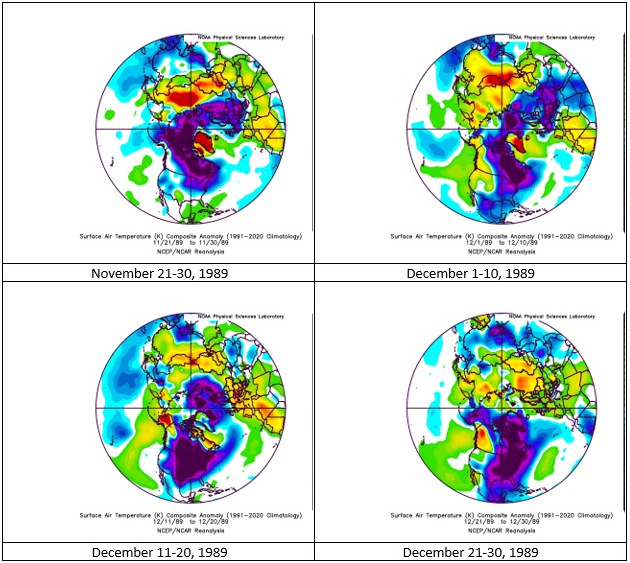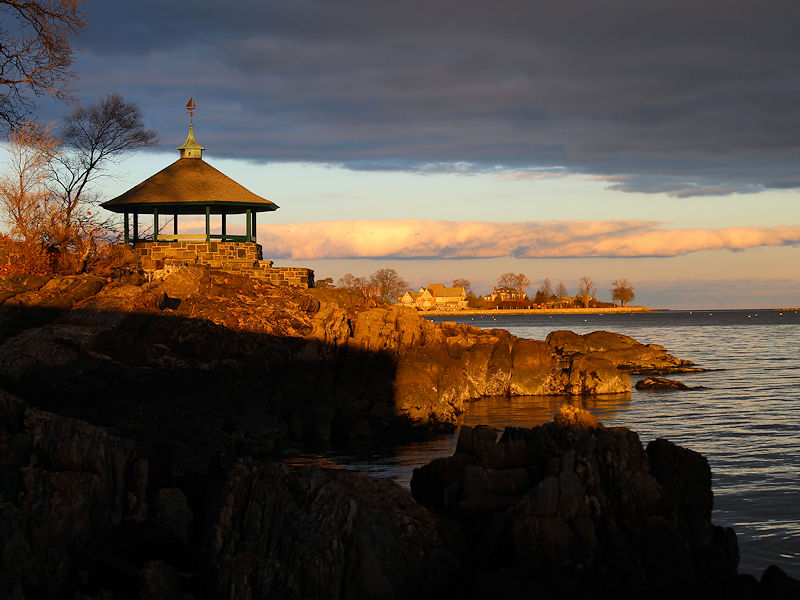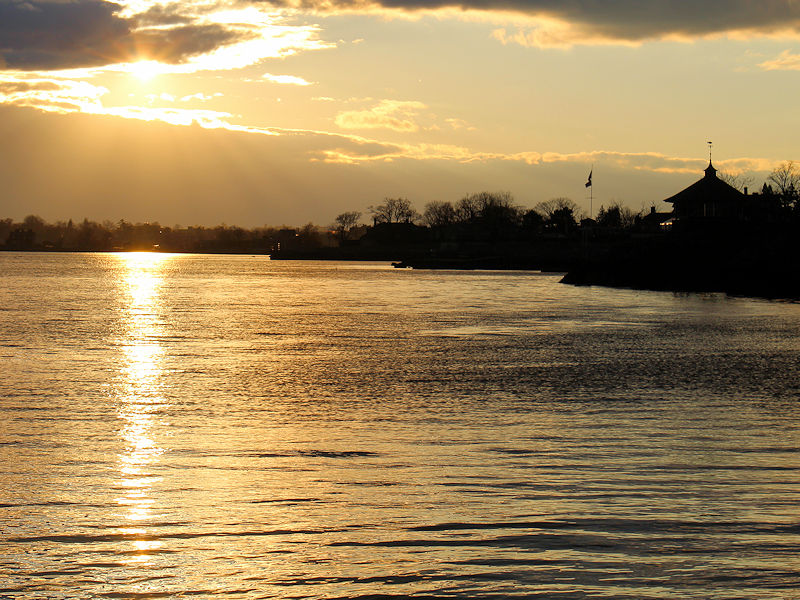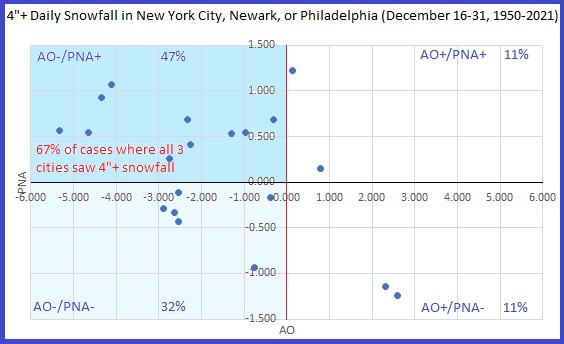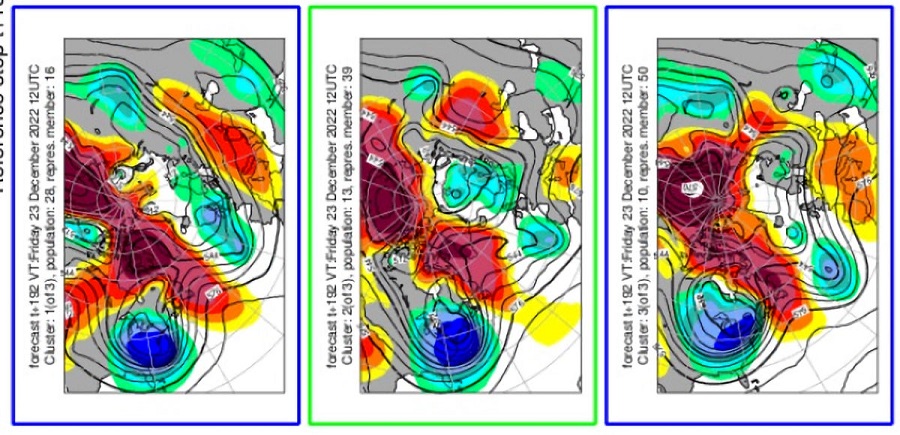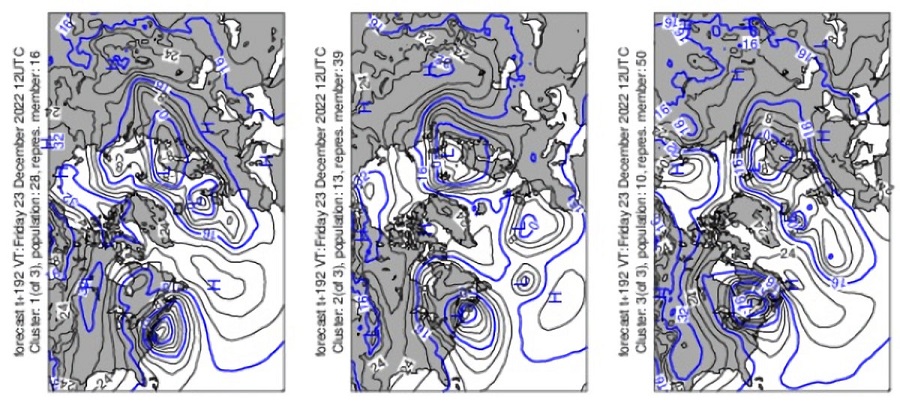-
Posts
22,981 -
Joined
Content Type
Profiles
Blogs
Forums
American Weather
Media Demo
Store
Gallery
Everything posted by donsutherland1
-
A warmup just before or around the New Year seems likely. Its duration and magnitude is far from certain. Some residual Atlantic blocking could persist in combination with a neutral or somewhat positive PNA. That could temper the warmth--warmer than normal at least for a time, but not necessarily record-challenging warmth. A popular argument might entail the MJO's returning to colder phases by mid-January (?) to argue for a return of colder weather, but MJO forecasts are low skill beyond 7-10 days.
-
It was a combination of factors that led to a persistent period of much below normal temperatures: 1. An expansive pool of abnormally cold air had been located on our side of the Northern Hemisphere, which was reinforced by strong cross-polar flow 2. There had been a persistent PNA ridge 3. There had been a nearly three week period of strong Atlantic blocking The cross-polar flow ended around December 21 with Atlantic blocking ending a day later. There was a lag before the coldest air mass of the season could be scoured out of the eastern U.S. But that happened as December closed. The last day of December saw the mercury reach a monthly high of 53° in New York City. Prior to that, the monthly high had been 48°. Pacific flow developed. By mid-January 1990, strong Pacific flow prevailed and most of the cold was located over Eurasia. Sustained winter weather was largely finished. The upcoming cold air mass, which will likely set records in parts of the Southern and Central Plains later this week is not as cold nor as expansive as the frigid December 1989 air mass. Moreover, a larger area of cold is located over Eurasia and areas of much greater warmth than had been present in 1989 prevail over many other parts of the Northern Hemisphere.
-
There was a 19-day period of blocking (December 3-21). The AO fell below -3 on two days during that blocking. The blocking rapidly dissipated starting on December 22, the cold departed shortly afterward (but not before a historic Southeast snowstorm) and then the remainder of the winter was generally very mild. The monthly average AO was -0.621. This month, we'll likely average well below -2.
-
Morning thoughts… Today will be partly to mostly sunny and cool. High temperatures will reach the upper 30s and lower 40s in most of the region. Likely high temperatures around the region include: New York City (Central Park): 40° Newark: 41° Philadelphia: 41° The dry weather will continue through Wednesday. Normals: New York City: 30-Year: 43.3°; 15-Year: 44.1° Newark: 30-Year: 43.8°; 15-Year: 44.8° Philadelphia: 30-Year: 45.0°; 15-Year: 46.0°
-
December 1989 had 1.4” of snow. The remainder of the winter saw 7.3” of snow.
-
Dry but cool weather will continue through Wednesday. Afterward, a powerful storm could bring heavy rain, high winds, and coastal flooding to the region Thursday and Friday. A general 1"-2" of precipitation appears likely with some locally higher amounts. A light snow accumulation remains possible at the onset of the storm and as it moves away from the region. Once that storm passes, the season's coldest air so far will pour into the region. Temperatures could tumble into the teens in New York City. The AO fell reached -4.000 on December 10th. Since 1950, there were 11 cases that saw the AO reach -4.000 or below during December. Mean snowfall for those cases was 9.0" (Median: 9.1"). 64% of such cases saw 6" or more of snowfall in December while 45% of such cases saw 10.0" or more snow. In contrast, during all other December cases, mean December snowfall was 3.5" (Median: 2.5"). 91% of those cases also saw a colder than normal December in the northern Middle Atlantic region. In terms of seasonal snowfall, 64% of those seasons saw 30" or more snowfall in New York City with 45% having 40" or more. Just 18% of such cases had less than 20" seasonal snowfall, both of which had less than 10" for the December-January period. However, there are cases where Decembers with strong blocking have seen much below normal snowfall. The three cases with less than 1" of monthly snowfall with a monthly average AO of -1.500 or below were: 1985: 0.9" (total seasonal snowfall: 13.0"); 1996: Trace (total seasonal snowfall: 10.0"); and, 2012: 0.4" (total seasonal snowfall: 26.1"). The lowest December snowfall when the AO averaged -2.000 or below was 5.1" in 1976. Total seasonal snowfall was 24.5". There is a chance that the December 1976 record futility could be surpassed this month. The ENSO Region 1+2 anomaly was -0.7°C and the Region 3.4 anomaly was -1.0°C for the week centered around December 7. For the past six weeks, the ENSO Region 1+2 anomaly has averaged -1.23°C and the ENSO Region 3.4 anomaly has averaged -0.95°C. La Niña conditions will likely persist through mid-winter. The SOI was +28.39 today. The preliminary Arctic Oscillation (AO) was -4.236 today. On December 16 the MJO was in Phase 4 at an amplitude of 0.602 (RMM). The December 15-adjusted amplitude was 0.607 (RMM). Based on sensitivity analysis applied to the latest guidance, there is an implied 75% probability that New York City will have a colder than normal December (1991-2020 normal). December will likely finish with a mean temperature near 37.7° (1.4° below normal).
-
Some delayed thoughts on the use of computer models in meteorology, as I was watching the World Cup. IMO, the computer models have reached the stage where, if even top-of-the-line meteorologists competed against the models head-to-head without computer guidance, the models would consistently perform better. Of course, meteorologists recognize how valuable the models are and how much they have progressed. They provide amazing insight and are powerful forecasting tools. Not surprisingly, the models are used widely. As for the upcoming storm, even as a plurality of ensemble members briefly showed a significant snowfall, there was also a distinctive minority that showed the outcome that now seems most likely. And, as a cautionary note, the national blend of models showed 2.5" snow for the New York City. That was a reasonable starting point that should have grounded expectations.
-
Yes. Kasparov has noted how impressive AI has become. It has enormous potential if used wisely.
-
It did. It even learned how to make sacrifices.
-
FYI: https://www.ecmwf.int/sites/default/files/elibrary/2021/19877-machine-learning-ecmwf-roadmap-next-10-years.pdf
-
Morning thoughts… Today will be partly to mostly sunny and cool. High temperatures will reach the upper 30s and lower 40s in most of the region. Likely high temperatures around the region include: New York City (Central Park): 40° Newark: 43° Philadelphia: 42° The dry weather will continue through Wednesday. Normals: New York City: 30-Year: 43.5°; 15-Year: 44.3° Newark: 30-Year: 44.0°; 15-Year: 45.0° Philadelphia: 30-Year: 45.3°; 15-Year: 46.2°
-
Tomorrow will be another cool but dry day. A powerful storm could bring heavy rain, high winds, and coastal flooding to the region late next week. A light snow accumulation remains possible at the onset of the storm and as it moves away from the region. Once that storm passes, the season's coldest air so far will pour into the region. Temperatures could tumble into the teens in New York City. The AO fell reached -4.000 on December 10th. Since 1950, there were 11 cases that saw the AO reach -4.000 or below during December. Mean snowfall for those cases was 9.0" (Median: 9.1"). 64% of such cases saw 6" or more of snowfall in December while 45% of such cases saw 10.0" or more snow. In contrast, during all other December cases, mean December snowfall was 3.5" (Median: 2.5"). 91% of those cases also saw a colder than normal December in the northern Middle Atlantic region. In terms of seasonal snowfall, 64% of those seasons saw 30" or more snowfall in New York City with 45% having 40" or more. Just 18% of such cases had less than 20" seasonal snowfall, both of which had less than 10" for the December-January period. The ENSO Region 1+2 anomaly was -0.7°C and the Region 3.4 anomaly was -1.0°C for the week centered around December 7. For the past six weeks, the ENSO Region 1+2 anomaly has averaged -1.23°C and the ENSO Region 3.4 anomaly has averaged -0.95°C. La Niña conditions will likely persist through mid-winter. The SOI was +21.23 today. The preliminary Arctic Oscillation (AO) was -2.548 today. On December 15 the MJO was in Phase 4 at an amplitude of 0.606 (RMM). The December 14-adjusted amplitude was 0.655 (RMM). Based on sensitivity analysis applied to the latest guidance, there is an implied 74% probability that New York City will have a colder than normal December (1991-2020 normal). December will likely finish with a mean temperature near 37.7° (1.4° below normal).
-
-
All the major models, except for the GFS, use the 4D-Var initialization scheme. NCEP decided to use something different rather than what remains the best-in-class approach. The growing gap in skill scores with two successive upgrades having slightly reduced scores over the versions they replaced are glaring red flags. Unfortunately, sunk cost fallacy seems to prevail and an inferior scheme is being retained.
-
The issue isn’t long-range forecasting per se, but long-range forecasting outside the context of probability. Skill deteriorates at longer timeframes. One should not view such forecasts through the lens of deterministic outcomes. Doing so can only lead to unnecessary and avoidable disappointment on account of an implicit underlying assumption that an outcome is guaranteed. That’s why, critics notwithstanding, I believe CPC’s 6-10/8-14 day forecasts using a probabilistic scheme are the way to go. They convey useful information and they respect uncertainty.
-
Expectations need to be anchored in probabilistic thinking. Otherwise, the expectations are unrealistic. Discussion of patterns e.g., with outcomes 40% above climatology do not mean that the outcomes are anything close to certain. Major or historic events are uncommon. Otherwise, they wouldn't be major, much less historic events. The coefficients of determination among variables is modest. A lot of other variables explain outcomes. Some factors are not well-understood e.g., a lot of work remains to be done on ocean-atmosphere interactions for specific events. Some variables may not even be known. Simplifications are representations. There are limits imposed by realities of the coefficients of determination. Dynamic changes created by a growing greenhouse effect also add complexity. Some events are inherently more complex than others. Phasing events are highly complex and difficult to forecast at medium-term or extended ranges. Occasionally, a model will have a good extended range outlook for a given event, but that's the exception not the rule. Forecasts related to the 1993 superstorm were an exception. Even with continuing advances in modeling, such outcomes cannot be replicated on anything approximating a consistent basis. Moreover, there is no "super model" that is decisively better than the others. Finally, 7-10-day discussions are about possibilities and should be understood as such. Operational guidance at that range is relatively low but not zero skill. Ensembles provide insight into plausible scenarios. Inside 5 days, confidence in outcomes can increase, but considerable uncertainty still exists. One cannot "lock in" solutions at such time scales when it comes to details, even as confidence in general ideas rises.
-
Morning thoughts… It will become partly cloudy. High temperatures will reach the lower and middle 40s in most of the region. Likely high temperatures around the region include: New York City (Central Park): 43° Newark: 45° Philadelphia: 44° Tomorrow will be another dry day. Normals: New York City: 30-Year: 43.8°; 15-Year: 44.6° Newark: 30-Year: 44.3°; 15-Year: 45.2° Philadelphia: 30-Year: 45.5°; 15-Year: 46.7°
-
The storm responsible for rain along the coast and some snow well inland will wind down tonight. So far, precipitation totals are in line with expectations. Amounts included: Albany: 1.76" (today's 1.60" set a daily record) Binghamton: 0.93" (7.3" of snow) Boston: 0.87" Bridgeport: 1.03" New York City: 1.28" Newark: 1.17" Philadelphia: 2.05" (yesterday's 1.90" set a daily record) Providence: 1.17" In the wake of the departing storm, a cold but dry weekend will follow. Late next week could see another storm bring precipitation to the region. Model solutions range from accumulating snow in the New York City-Newark area to a potential Ohio Valley/Great Lakes blizzard. Details remain to be sorted out, but the latter scenario is currently the favored one on the ensembles. Once that storm passes, the season's coldest air so far will pour into the region. The latest EPS weeklies continue to suggest that near normal to below normal temperatures could prevail during the December 19-26 and December 27-January 2 periods. No severe cold is likely through at least the first three weeks of December. Afterward, as the PNA goes neutral, the prospect for snowfall and more significant cold could increase. The AO fell reached -4.000 on December 10th. Since 1950, there were 11 cases that saw the AO reach -4.000 or below during December. Mean snowfall for those cases was 9.0" (Median: 9.1"). 64% of such cases saw 6" or more of snowfall in December while 45% of such cases saw 10.0" or more snow. In contrast, during all other December cases, mean December snowfall was 3.5" (Median: 2.5"). 91% of those cases also saw a colder than normal December in the northern Middle Atlantic region. In terms of seasonal snowfall, 64% of those seasons saw 30" or more snowfall in New York City with 45% having 40" or more. Just 18% of such cases had less than 20" seasonal snowfall, both of which had less than 10" for the December-January period. The ENSO Region 1+2 anomaly was -0.7°C and the Region 3.4 anomaly was -1.0°C for the week centered around December 7. For the past six weeks, the ENSO Region 1+2 anomaly has averaged -1.23°C and the ENSO Region 3.4 anomaly has averaged -0.95°C. La Niña conditions will likely persist through mid-winter. The SOI was +11.83 today. The preliminary Arctic Oscillation (AO) was -2.548 today. On December 14 the MJO was in Phase 4 at an amplitude of 0.652 (RMM). The December 13-adjusted amplitude was 0.751 (RMM). Based on sensitivity analysis applied to the latest guidance, there is an implied 75% probability that New York City will have a colder than normal December (1991-2020 normal). December will likely finish with a mean temperature near 37.7° (1.4° below normal).
-
Radical differences lead to radically different outcomes.
-
At present, neither mourning nor celebration is in order for the potential December 23-24 storm. The picture will be getting clearer after the coming weekend. Phasing events are complex and details matter greatly. At extended ranges, even the best models don't fully resolve the details. With the PNA forecast to be rising to neutral or somewhat positive levels coupled with a strongly negative AO, the region has its highest probability relative to climatology for at least an appreciable snowfall. Nearly half of all December 16-31 days with 4" or more snowfall in either New York City, Newark, or Philadelphia during 1950-2021 have occurred with an AO-/PNA+ pattern (and two thirds of storms with daily snowfall of 4" or more in all three cities). There are no guarantees, of course. Some similar patterns deliver very little (December 1950). Others deliver large amounts of snow (December 2010 into January 2011). The majority of 12/16 0z EPS individual ensemble members have measurable snowfall and a small cluster (around 15%) have 10" or more snowfall in the region. Cluster analysis supports the idea of multiple scenarios being on the table. The 12z guidance will provide additional insight. A good starting point for a potential event that is still 144-192 hours away is probably the 12/16 15z run of the National Blend of Models (NBM). The , which currently shows about 2.5" of snow in New York City, Newark, and Philadelphia.
-
The 12/16/2022 0z EPS 500 mb clusters. Still plenty of opportunity for a snowy solution. Whether the number of scenarios gives hope to the hopeless or hopelessness to the hopeful remains to be seen.
-
Morning thoughts… Today will be rainy and windy. Winds could gust past 40 mph at times. High temperatures will reach the middle and perhaps upper 40s in most of the region. Likely high temperatures around the region include: New York City (Central Park): 46° Newark: 47° Philadelphia: 47° Dry weather will return tomorrow and a quiet weekend is in store. Normals: New York City: 30-Year: 44.1°; 15-Year: 44.8° Newark: 30-Year: 44.6°; 15-Year: 45.5° Philadelphia: 30-Year: 45.8°; 15-Year: 47.0°
-
Congratulations.
-
-
A complex storm will continue to bring a cold rain to coastal regions tomorrow. Some of the rain could be heavy. A general 0.50"-1.50" with locally higher amounts is likely. Interior sections could see some additional accumulating snow. An area of moderate to significant snowfall is likely across central Pennsylvania to central New York State. The latest EPS weeklies continue to suggest that near normal to below normal temperatures could prevail during the December 19-26 and December 27-January 2 periods. No severe cold is likely through at least the first three weeks of December. Afterward, as the PNA goes neutral, the prospect for snowfall and more significant cold could increase. Already, the guidance is showing an increased change of snow for the December 22-24 timeframe. The AO fell reached -4.000 on December 10th. Since 1950, there were 11 cases that saw the AO reach -4.000 or below during December. Mean snowfall for those cases was 9.0" (Median: 9.1"). 64% of such cases saw 6" or more of snowfall in December while 45% of such cases saw 10.0" or more snow. In contrast, during all other December cases, mean December snowfall was 3.5" (Median: 2.5"). 91% of those cases also saw a colder than normal December in the northern Middle Atlantic region. In terms of seasonal snowfall, 64% of those seasons saw 30" or more snowfall in New York City with 45% having 40" or more. Just 18% of such cases had less than 20" seasonal snowfall, both of which had less than 10" for the December-January period. The ENSO Region 1+2 anomaly was -0.7°C and the Region 3.4 anomaly was -1.0°C for the week centered around December 7. For the past six weeks, the ENSO Region 1+2 anomaly has averaged -1.23°C and the ENSO Region 3.4 anomaly has averaged -0.95°C. La Niña conditions will likely persist through mid-winter. The SOI was +4.15 today. The preliminary Arctic Oscillation (AO) was -3.216 today. December 1-15 has experienced the strongest AO block on record for the first half of December. The AO averaged a preliminary -2.908 (old record: -2.138, 1985) with 8 days at or below -3.000 (old record: 6 days, 1966). On December 13 the MJO was in Phase 4 at an amplitude of 0.743 (RMM). The December 12-adjusted amplitude was 1.070 (RMM). Based on sensitivity analysis applied to the latest guidance, there is an implied 71% probability that New York City will have a colder than normal December (1991-2020 normal). December will likely finish with a mean temperature near 37.9° (1.2° below normal).





